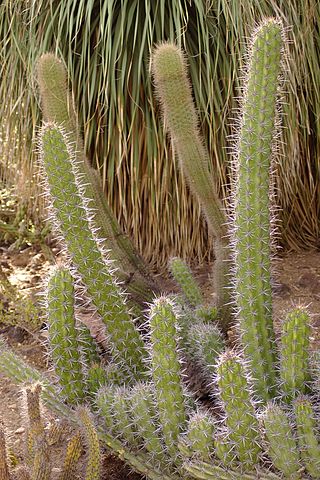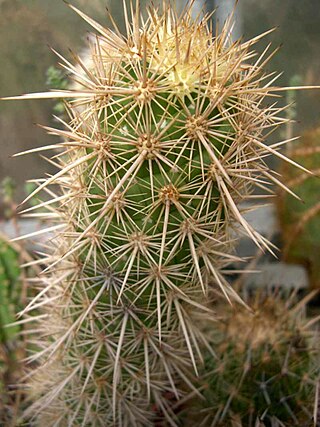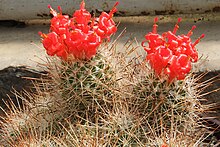
Cochemiea guelzowiana is a species of plant in the family Cactaceae. The species epithet guelzowiana honors the German cactus collector Robert Gülzow of Berlín.

Ferocactus peninsulae is a barrel cactus in the genus Ferocactus of the family Cactaceae.

Lophocereus schottii, the senita cactus, is a species of cactus from southern Arizona and north-western Mexico, particularly Baja California and Sonora. Ultramafic soils facilitate the endemism of plant species and are often associated with their distribution.

Pachycereus pecten-aboriginum is a columnar cactus plant native to Mexico. They can grow up to 15 m (49 ft) high. The trunk of this species is 1.2 to 5.0 m tall and the fruits are large and burr-like. The specific name, pecten-aboriginum, is from the Latin, and means "native combs". It was inspired by the use of the fruits as hair combs.

Lobivia cinnabarina is a species of cactus first described in 1885.

Echinocereus poselgeri, also known as the dahlia cactus, is a species of Echinocereus. It is native to Coahuila and southern Texas.

Cochemiea barbata is a small cactus native to Chihuahua, Sonora, and Durango, with the common name greenflower nipple cactus.

Cochemiea conoidea, common name Texas cone cactus or Chihuahuan beehive, is a species of cactus native to southern United States to central Mexico.

Ferocactus diguetii, commonly known as the giant barrel cactus, is the largest species of barrel cactus in the genus Ferocactus. It is an insular species endemic to several of Baja California Sur's southern islands in the Gulf of California. As the superlative giant of the barrel cacti, it reaches heights of up to 4 metres (13 ft) and diameters of 1 metre (3.3 ft) in the wild, a result of island gigantism. The species has red flowers that bloom from March to May. Although restricted in range, this species grows in protected habitat and lacks major threats.

Ferocactus gracilis, the fire barrel cactus, is a species of Ferocactus from Northwestern Mexico. This cactus gets its common name from the striking red coloration of its defensive spines and flowers.

Stenocereus gummosus is a flowering plant in the family Cactaceae that is found in Baja California, Mexico at elevations of 9 to 134 meters

Cochemiea albicans is a species of Cochemiea found in Mexico.
Cochemiea cerralboa is a species of Cochemiea found in Mexico.

Cochemiea halei is a species of Cochemiea found in Mexico.
Cochemiea pondii is a species of Cochemiea found in Mexico.

Echinocereus barthelowianus is a species of cactus native to Mexico.

Echinocereus brandegeei is a species of cactus native to Mexico.

Echinocereus maritimus is a species of cactus native to Mexico.

Echinocereus nicholii is a species of cactus native to Mexico.

Echinocereus scopulorum is a species of cactus native to Mexico.

























